微生物吸收营养物质的方式1
微生物对营养物质的吸收

微生物对营养物质的吸收微生物从外界摄取营养物质的方式随微生物类群和营养物质种类而异,可归纳为吞噬和渗透吸收两种类型。
多数原生动物能直接以细胞质膜包围并吞食营养物。
原生动物对固体颗粒状食物的捕食称为吞噬,对液体或胶体状小液滴状食物的捕食称为胞饮。
绝大多数微生物以渗透方式吸收营养物质。
以渗透方式通过细胞质膜从环境或寄主细胞中获取营养物质的微生物有细菌、放线菌、蓝细菌、藻类、真菌、原生动物中的孢子虫和鞭毛虫等。
微生物个体微小,比表面大,能高效率地进行细胞内外的物质交换。
影响营养物质进入细胞的的因素主要有三个: 其一是营养物质本身的性质。
分子量、溶解性、电负性、极性等都影响营养物质进入细胞的难易程度。
其二是微生物所处的环境。
温度通过影响营养物质的溶解度、细胞膜的流动性及运输系统的活性来影响微生物的吸收能力;pH和离子强度通过影响营养物质的电离程度来影响其进入细胞的能力。
例如,当环境pH比胞内pH高时,弱碱性的甲胺进入大肠杆菌后以带正电荷的形式存在,而这种状态的甲胺不容易分泌而导致细胞内甲胺浓度升高,当环境pH比胞内pH低时,甲胺以带正电荷的形式存在于环境中而难以进入细胞,导致细胞内甲胺浓度降低;当环境中存在诱导物质运输系统形成的物质时,有利于微生物吸收营养物质。
而环境中存在的代谢过程抑制剂、解偶联剂以及能与原生质膜上的蛋白质或脂类物质等成份发生作用的物质(如巯基试剂、重金属离子等)都可以在不同程度上影响物质的运输速率。
另外,环境中被运输物质的结构类似物也影响微生物细胞吸收被运输物质的速率,例如L-刀豆氨酸、L-赖氨酸或D-精氨酸都能降低酿酒酵母吸收L-精氨酸的能力。
其三是微生物细胞的透过屏障(permeability barrier)。
所有微生物都具有一种保护机体完整性且能限制物质进出细胞的透过屏障,渗透屏障主要由原生质膜、细胞壁、荚膜及粘液层等组成的结构。
荚膜与粘液层的结构较为疏松,对细胞吸收营养物质影响较小。
大学微生物复习--第4章 微生物的营养和代谢1
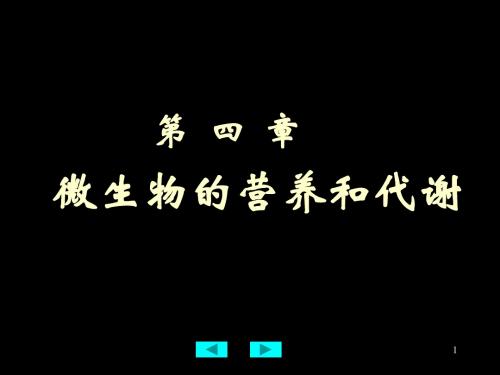
几种微生物生长的最适aw值
微生物 一般细菌 酵母菌 霉菌 嗜盐细菌 嗜盐真菌 嗜高渗酵母菌
aw
0.91 0.88 0.80 0.76 0.65 0.60
17
二、微生物吸收营养物质的方式
1. 简单扩散
物质运输的动力: 膜内外的浓度差 特点:
A. 不消耗能量
B. 不发生化学变化 C. 非特异性。
45
微生物在厌养条件下的发酵过程的前部反应
46
酵母菌的乙醇发酵
C6H12O6 + 2ADP + 2 H3PO4 2CH3CH2OH + 2 ATP + 2CO2+2H2O
47
乳酸细菌的正型乳酸发酵
C6H12O6 + 2ADP + 2Pi
2CH3CHOHCOOH + 2ATP + 2H2O
48
(二)呼 吸
葡萄糖,果糖,半乳糖,甘露糖 麦芽糖,蔗糖,乳糖,纤维二糖 淀粉,纤维素,半纤维素,甲壳素
4
有机酸:
乳酸,柠檬酸,延胡索酸,低级脂肪酸,高 级脂肪酸,氨基酸
醇类:
乙醇、甲醇
脂类:
脂肪,磷脂
5
烃类: 天然气,石油,石油馏分,石蜡油 CO2: CO2 碳酸盐: NaHCO3, CaCO3, 其他: 芳香族化合物,氰化物,蛋白质,肽, 核酸
31
1. 适宜营养物质的选择
32
2. 营养物质浓度及配比合适(C/N) 碳氮比(C/N):培养基中碳元素/氮元素 物质的量比值或还原糖与粗蛋白之比。
谷氨酸发酵生产: C/N=4时菌体大量繁殖,Glu积累少; C/N=3时菌体繁殖受抑,Glu大量积累。
33
3. 控 制 pH 条 件 细菌: pH7.0~8.0
农业微生物学试题及答案

农业微生物学一、名词解释1. 生长曲线2. 氨化作用3. 培养基4. 拮抗作用5. 菌落6. 朊病毒7. 拮抗作用8. 微生物9. 生物固氮10. 鞭毛11. 消毒12. 微生物连续培养13. 真核微生物14. 支原体15. 假根16. 霉菌17. 芽孢18. 生物固氮19. 衣原体20. 捕食作用二、简答题1. 简述温度对微生物的影响2. 简述革兰氏染色方法及其机理3. 试分析微生物的五大共性与人类的关系4. 微生物杀虫剂的种类5. 微生物在医疗保健战线上的六大“战役”6. 如何防治植物病毒病7. 试述微生物吸收营养物质的方式8. 微生物在工业发展过程中的六个里程碑9. 微生物肥料的种类10. 如何防止菌种退化11. 试述培养基配制是应该注意的四个问题12. 微生物的连续培养三、论述题1. 论述氮素循环途径及微生物在氮素循环中的作用2. 论述微生物与绿色农业的关系3. 试述微生物生长曲线及其各个时期的特点4. 生物固氮的必要条件5. 举例说明微生物多样性和环境适应性及其用于农业生产中的实例6. 微生物的六大营养要素7. 高温杀菌的种类及其影响因素农业微生物学答案一、名词解释1. 生长曲线:在分批培养中,以细胞数目的对数值作纵坐标,以培养时间作横坐标,就可以画出一条有规律的曲线,这就是微生物的典型生长曲线。
2. 氨化作用:就是微生物将有机氮化物转化成氨的过程。
3. 培养基:培养基是一种人工配制的、适合微生物生长繁殖或产生代谢产物的营养基质4. 拮抗作用:由某种微生物的生长而引起的其他条件改变抑制或杀死他种生物的现象。
5. 菌落:微生物在固体培养基上局限一处大量繁殖,形成肉眼可见的群体,即称为菌落。
6. 朊病毒:朊病毒在电子显微镜下呈杆状颗粒、直径26nm,长100~200nm(一般为125~150nm)。
7. 拮抗作用:所谓拮抗,系指由某种生物所产生的某种代谢产物可抑制他种生物的生长发育甚至杀死它们的一种相互关系。
环境微生物学试题库(五)

环境微生物学试题库(五)一、单项选择题(每小题1分,共15分,在下列每小题的四个备选答案中选出一个正确的答案,并将其字母标号填入题干的括号内。
)1.微生物学初创时期的代表人物是()。
A.巴斯德B.科赫C.列文·虎克D.维诺格拉德斯基2.噬菌体是侵染()的病毒。
A.植物B.细菌C.动物D.动物和植物3.放线菌具吸收营养和排泄代谢产物功能的菌丝是()。
A.基内菌丝B.气生菌丝C.孢子丝D.孢子4.丝状真菌的无性繁殖方式中,主要的方式是()。
A.菌丝片断B.芽殖C.裂殖D.无性孢子5.以下有关碳源的描述错误的是:()。
A.微生物碳源包括无机碳和有机碳B.碳源提供微生物细胞碳的骨架C.碳源是所有微生物生长的能源D.碳源是微生物代谢产物中碳的来源6.营养物质进入细胞的方式中运送前后物质结构发生变化的是()。
A.主动运输B.被动运输C.促进扩散D.基团移位7.代谢过程为了产生ATP分子,所有下面的物质都是需要的,除了()之外。
A.二磷酸腺苷分子B.能量C.磷酸基D.DNA和RNA8.细菌中参加光合作用的是()。
A.紫细菌和绿硫细菌B.肠的细菌如大肠杆菌C.土壤细菌如放线菌D.立克次氏体和衣原体9.一般情况下,活性污泥驯化成熟期最多的原生动物是()。
A.鞭毛虫B.钟虫C.变形虫D.绿眼虫10.实验室常规高压蒸汽灭菌的条件是()。
A.135℃—140℃,5—15秒B.72℃,15秒C.121℃,30分钟D.100℃,5小时11.下列有关腐生细菌的描述不正确的是:()。
A.腐生细菌是化能异养型的B.腐生细菌只能从死的有机残体中获得养料C.腐生细菌在自然界的物质循环中起决定性作用D.自然界大多数细菌属于腐生细菌12.微生物吸收营养物质的主要方式是()。
A.简单扩散B.促进扩散C.主动运输D.基团转位13.在废水分析中,大肠埃希氏菌作为()。
A.水中粪便污染的指示B.进行平板计数的常规生物C.水中固氮菌数量指示D.水中氨基酸含量的尺度14.纯培养是其中()的培养物。
微生物试题

微生物试题) 名词解释1.生长2.繁殖3.菌落形成单位(cfu)4.同步生长5.连续发酵6.最适生长温度7.专好养菌8.兼好养菌9.厌氧菌10.Hungate滚管技术11.巴氏消毒法12.间歇灭菌法13.石炭酸系数14.抗生素15.抗代谢药物16.选择毒力17.抗菌谱18.连续加压蒸汽灭菌法(二)选择题(选出一个最合适的答素)1.嗜冷菌是指最适生长———的细菌。
A.在无氧环境B.在pH 8或8以上C.在冷的温度D.只有病毒存在时2.微生物在干旱环境中存活是因为———。
A.形成芽孢B.只代谢葡萄糖分子C.没有细胞膜D.没有染色体3.甘露醇盐琼脂是培养基的一个例子,供养———。
A.病毒B.衣原体和立克次体C.原生动物和真菌D.某些细菌4.实验室固氮细菌培养基能够加宫通过———。
A.添加ATP B.添加蛋白胨C.添加纯水D.添加钾的水平5.称为微好氧菌的那些细菌能———生长。
A.在高浓度盐中B.在低浓度盐中C.没有ATP或葡萄糖D.在人的口腔内6.有丝分裂过程发生在———。
A.只在细菌中B.在病毒和细胞中C.在真核生物中D.只在化学限定培养基中7.所有微生物的世代时间———。
A.不同B.在30分钟之内C.为3h D.为12h8.出芽繁殖的过程———发生。
A.主要在病毒中B.在形成分支的细菌中C.只在原生动物中D.在酵母菌中9.微生物处于稳定生长前期时————。
A.细胞分裂速率增加B.细胞分裂速率降低C.群体是在其最旺盛壮健的阶段D.群体是在其最少的阶段10.人体病原菌生长的温度在———。
A.100℃B.体温C.像病毒一样的温度D.嗜热的温度11.鉴别培养基是一种培养基,———。
A.其初始pH不同B.可辨别两种不同特的细菌C.有两种不同细菌所用不同地殊营养物D.保温培养期采用两种不同的温度12.直接显微镜计数用来测定下面所有微生物群体的数目,除了———之外。
A.原生动物B.真菌孢子C.细菌D.病毒13.生活在pH 5—8.5范围的那些微生物称为———。
生物获取营养的方式

生物获取营养的方式
生物是指所有生命体,包括植物、动物、微生物等。
生物需要营养来维持生命活动,而营养的获取方式因生物的不同而有所不同。
植物是通过光合作用来获取营养的。
光合作用是指植物利用光能将二氧化碳和水转化为有机物质的过程。
在光合作用中,植物利用叶绿素吸收光能,将二氧化碳和水转化为葡萄糖等有机物质,并释放出氧气。
这些有机物质可以被植物利用来维持生命活动。
动物则需要通过摄食来获取营养。
摄食是指动物通过口腔将食物摄入体内,经过消化吸收后获取营养的过程。
动物的消化系统包括口腔、食管、胃、小肠、大肠等器官。
在消化过程中,食物被分解成小分子,如葡萄糖、氨基酸、脂肪酸等,这些小分子可以被动物吸收利用。
微生物的营养获取方式也有所不同。
有些微生物可以通过光合作用来获取营养,如蓝藻、一些细菌等。
而另一些微生物则是通过分解有机物质来获取营养,如细菌、真菌等。
这些微生物可以分解死亡的植物和动物体内的有机物质,将其转化为有机物质和无机物质,从而获取营养。
生物获取营养的方式因生物的不同而有所不同。
植物通过光合作用来获取营养,动物通过摄食来获取营养,而微生物则有多种方式来获取营养。
这些方式都是生物维持生命活动所必需的。
第二节微生物对营养物质的吸收(精)

回本章目录
回本章目录
类型
浓度 梯度 顺 顺 逆 逆
能量 需要 否 否 是 是
载体 平衡点 渗透酶 无 有 有 有 不改变 不改变 改变 改变
实例
单纯 扩散
促进 扩散 主动 运输 基团 转移
水
气体分子 金属离子
氨基酸 大部分 物质
糖类
回本章目录
第三节 微生物的营养类型
一、概述
微生物对营养物质的利用,就其总体 而言,地球上几乎没有一种有机物不被他 们所利用,但就某一种而言,他们所需要 的营养物却有一定范围。 根据微生物对碳源的要求是无机碳化合物 还是有机化合物可以把微生物分为自养型 微生物和异养型微生物两大类。
回本章目录
二、营养吸收方式
1.被动扩散(单纯扩散)
利用浓度差,从高向低扩散,不消耗能 量,非特异性(无选择性),速度慢。
回本章目录
回本章目录
2.促进扩散
利用浓度差,不消耗能量,多见于真核生物。 有一种载体像渡船一样运输,可大大加快速度, 这种载体是一种蛋白质,称为透过酶/渗透酶。
回本章目录
3.主动运输
光合色素 光
回本章目录
三、化能自养型微生物 Chemoautotrophs
这一类微生物有氧化一些无机 物(H2S,FeCO3,NH4+,NO3-)的能力, 利用氧化无机物时产生的能量(化 学能),把二氧化碳 CO2 或可溶性 的碳酸盐 CO32-还原成有机碳化物。
回本章目录
这些微生物仅限一些细菌:氢 细菌,硫细菌,铁细菌,氨细菌和 亚硝酸细菌共五类。 他们在产能过程中,需要大量 氧气,所以所有的化能自养型微生 物均为好氧菌。
回本章目录
一、营养物质与营养
微生物习题及答案4
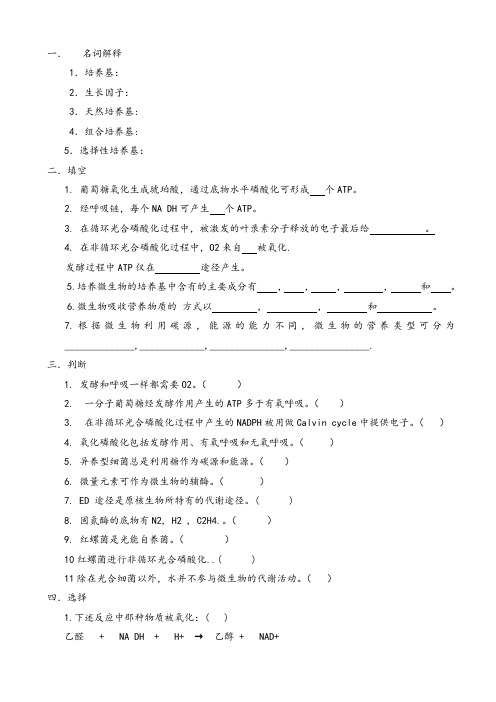
一.名词解释1.培养基:2.生长因子:3.天然培养基:4.组合培养基:5.选择性培养基:二.填空1.葡萄糖氧化生成琥珀酸,通过底物水平磷酸化可形成个ATP。
2.经呼吸链,每个NA DH可产生个ATP。
3.在循环光合磷酸化过程中,被激发的叶录素分子释放的电子最后给。
4.在非循环光合磷酸化过程中,O2来自被氧化.发酵过程中ATP仅在途径产生。
5.培养微生物的培养基中含有的主要成分有,,,,和。
6.微生物吸收营养物质的方式以,,和。
7.根据微生物利用碳源,能源的能力不同,微生物的营养类型可分为______________,_____________,_______________,________________.三.判断1. 发酵和呼吸一样都需要O2。
()2. 一分子葡萄糖经发酵作用产生的ATP多于有氧呼吸。
()3. 在非循环光合磷酸化过程中产生的NADPH被用做Calvin cycle中提供电子。
()4. 氧化磷酸化包括发酵作用、有氧呼吸和无氧呼吸。
()5. 异养型细菌总是利用糖作为碳源和能源。
()6. 微量元素可作为微生物的辅酶。
()7. ED 途径是原核生物所特有的代谢途径。
( )8. 固氮酶的底物有N2, H2 , C2H4.。
()9. 红螺菌是光能自养菌。
()10红螺菌进行非循环光合磷酸化..( )11除在光合细菌以外,水并不参与微生物的代谢活动。
()四.选择1.下述反应中那种物质被氧化:( )乙醛 + NA DH + H+ →乙醇 + NAD+A 乙醛B NA DHC NAD+D 乙醇2. 通过有氧代谢,下述那个反应产生的ATP最多:( )A 葡萄糖→ 6-磷酸葡萄糖B 葡萄糖→丙酮酸C 琥珀酸→延胡索酸3. 下述过程那个不产生ATP ( )A 光合磷酸化B 氧化磷酸化C 底物水平磷酸化D Calvin cycle4. 葡萄糖彻底氧化包括那三个典型的阶段:( )A 化学渗透,光合磷酸化,还原B 葡萄糖降解,TCA循环,电子传递链C 底物水平磷酸化,Calvin cycle,TCA循环D 光合作用,发酵,氧化5. 葡萄糖降解过程中,来自葡萄糖氧化产生的电子传递给:( )A NA DHB NAD+C FAD+D FADH6. 异养生物利用有机物作能源和碳源,产生5碳中间产物供合成核酸,利用的途径是:( )A 混合酸发酵途径 B循环光合磷酸化 C TCA循环 D HMP途径7. TCA循环产生ATP的过程属于 ( )A 氧化磷酸化B 底物水平磷酸化 C光合磷酸化 D 电子传递链8.下述那个是呼吸链的最终步骤 ( )A NAD+ 形成B 质子被转移到膜外C 电子传递给氧D NA DH 被氧化9.下列那个分子可作为无氧呼吸的末端电子受体:( )A cAMPB PO4+C NO3+D O210.下述那个不可能是发酵终产物 ( )A 丙酮酸B CO2C 乙酸D 乳酸11.下列属于化能自养微生物的是()A 亚硝化细菌B 光合细菌C 蓝细菌D 霉菌12.中稳型微生物最适生长温度(℃)是()A 35-40B 10-20C 20-35D A和C二.问答1.举例说明微生物的营养类型有那些,其划分依据是什么?2.pH值对微生物生长有何影响?3.什么是生长因子,他包括哪几类化合物?二.名词解释1.培养基是指由人工配置的、适合微生物生长繁殖或产生代谢产物用的混合营养料。
第五章微生物的营养与代谢介绍

由光照引起的电子传递作用与磷酸化作用相偶联而生成ATP 的过程,即将光能转化为化学能的过程。
非环式光 合磷酸化
真核生物:藻类及绿色植物 原核生物:蓝细菌
光能营养 微生物
环式光合 磷酸化
真细菌:光合细菌
紫膜光合磷酸化:嗜盐菌
1、非环式光合磷酸化
特点: ①有氧条件下进行 ②有PSⅠ和PS Ⅱ2个光合系统 ③同时产生还原力、ATP和O2 ④还原力来自H2O的光解
控制在适宜的范围之内; ➢ 灭菌处理:培养基应无菌。 ➢ 经济节约:所用原料应遵循经济节约、来源广泛的原则。
复合培养基
含有化学成分还不清楚或化学成 分不恒定的天然有机物
细菌(牛肉膏蛋白胨培养基):
牛肉膏 3g 蛋白胨 10g NaCl 5g H2O 1000ml
按
成
分
化学成分不详和化学成分已知
不
半合成培养基 的化合物配成的培养基。
✓ Respiration chain 呼吸链:指从葡萄糖或其他氧化型化合 物上脱下的氢(电子)经过一系列按照氧化还原势由低到高
顺序排列的氢(电子)传递体,定向有序的传递系统。
特点:物质氧化产生的质子和电子,通过一系列电子传递体,传给末
端电子受体,并在此过程中生成ATP,即电子传递与磷酸化相偶联
光合磷酸化
2、抑制性选择培养基
培养基中加入某种化学物质,这种化学物质没有营养作用, 对所需分离的微生物无害,但可以抑制或杀死其他微生物。 如结晶紫、抗生素等。
鉴别培养基
在成分中加有能与目的菌的无色代谢产物发生明 显显色反应的指示剂,从而达到只需肉眼就能方 便地从近似菌落中找出目的菌落的培养基。
伊红美蓝乳糖培养基(EMB培养基)
磷酸烯醇 式丙酮酸
微生物营养方式

基因移位在Escherichiacoli(大肠杆菌)和 Staphylococcusaureus(金黄色葡萄球菌)中研 究得较多。
:膜泡运输的基本概念
真核细胞通过内吞作用(endocytosis)和外 排作用(exocytosis)完成大分子与颗粒性 物质的跨膜运输。在转运过程中,质膜内 陷,形成包围细胞外物质的囊泡,因此又 称膜泡运输。细胞的内吞和外排活动总称 为吞排作用(cytosis)。
营养物质进入细胞的方式
对绝大多数属于渗透营养型的微生物来说,营养 物质通过细胞膜进入细胞的问题,是一个较复杂 又很重要的生理学问题。据目前所知,细胞壁在 营养物质运送上不起多大作用,仅简单地排阻分 子量过大(>600Da)的溶质的进入,而具有磷脂双 分子层和嵌合蛋白分子的细胞膜则是控制营养物 进入和代谢产物排出的主要屏障。一般认为,细 胞膜以四种方式控制物质的运送,即单纯扩散、 促进扩散、主动运送和基团移位,其中尤以主动 运送为最重要:
外排作用
四、穿胞运输 在动物组织中,有的细胞通过内吞和外排相偶联,在细胞
的一侧形成胞饮小泡穿越细胞质,另一侧使小泡中的物质 释放出去。如:肝细胞从血窦中吸收免疫球蛋白A (IgA),通过穿胞运输输送到胆微管;大鼠中,母鼠血 液中抗体经穿胞运输进入乳汁。 五、胞内膜泡运输 细胞内部内膜系统各个部分之间的物质传递也通过膜泡运 输方式进行。如从内质网到高尔基体;高尔基体到溶酶体; 细胞分泌物的外排,都要通过过渡性小泡进行转运。胞内 膜泡运输沿微管运行,动力来自马达蛋白(motor proteins)。目前已发现的马达蛋白有两种:一种是动力 蛋白(dynein),可沿微管向负端移动;另一种为驱动蛋 白(kinesin),可牵引物质向微管的正端移动。通过这两 种蛋白的作用,可使膜泡被运抵一定区域。关于胞内膜跑 运输我们将在专门的章节进行较为详细的讲解。
微生物营养方式

一、单纯扩散
单纯扩散(simplediffusion)又称被动运送 (passivetransport)。细胞膜这层疏水性屏障可以通 过物理扩散方式让许多小分子、非电离分子尤其 是亲脂性的分子被动地通过,这就是单纯扩散。 这类物质的种类不多,主要是氧、二氧化碳、乙 醇和某些氨基酸分子,还没有发现过糖分子可通 过单纯扩散而进入细胞的例子。单纯扩散不是细 胞获取营养物质的主要方式,因为细胞既不能通 过它来选择必需的营养成分,也不能将稀溶液中 的溶质分子进行逆浓度梯度运送,以满足细胞的 需要
二、胞饮作用 细胞吞入的物质为液体或极小 的颗粒物质(图5-14),这种 内吞作用称为胞饮作用 (pinocytosis)。胞饮作用存在 于白细胞、肾细胞、小肠上皮 细胞、肝巨噬细胞和植物细胞。
三、外排作用 与内吞作用的顺序相反,某些大分子物质 通过形成小囊泡从细胞内部移至细胞表面, 小囊泡的膜与质膜融合,将物质排出细胞 之外,这个过程称为外排作用 (exocytosis),细胞内不能消化的物质和 合成的分泌蛋白都是通过这种途径排出的 (图5-15)。
四、基团移位
基因移位(grouptranslocation)也是一种既需特异性载体蛋白 又须耗能的运送方式,但溶质在运送前后会发生分子结构 的变化,因而不同于上述的主动运送。 基因移位主要用于运送葡萄糖、果糖、甘露糖、核苷酸、 丁酸和腺嘌呤等物质。以葡萄糖为例,其特点是每输入一 个葡萄糖分子,就要消耗一个ATP的能量。运送的机制是 依靠磷酸转移酶系统,即磷酸烯醇式丙酮酸-己糖磷酸转 移酶系统。其运送的步骤为: (1)热稳载体蛋白(HPr,heat-stablecarrierprotein)的激活细胞 内高能化合物磷酸烯醇式丙酮酸(PEP)的磷酸基团把HPr激 活。HPr是一种低分子量的可溶性蛋白质,结合在细胞膜 上,具有高能磷酸载体的作用。酶1是一种可溶性的细胞 质蛋白。
《食品微生物学》2022年思考题(讨论)
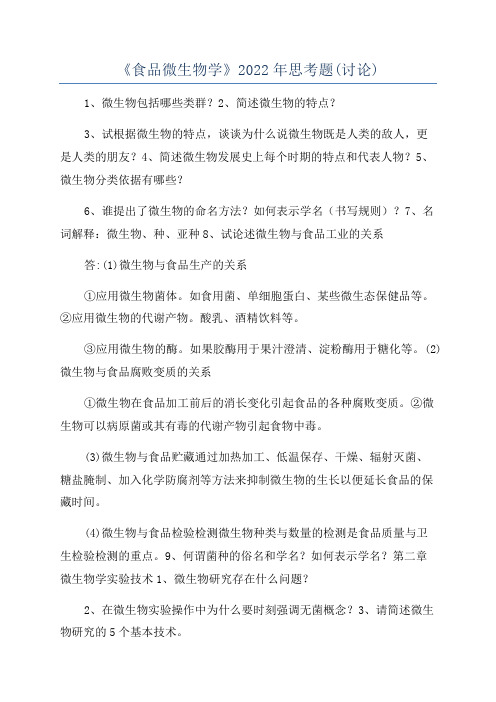
《食品微生物学》2022年思考题(讨论)1、微生物包括哪些类群?2、简述微生物的特点?3、试根据微生物的特点,谈谈为什么说微生物既是人类的敌人,更是人类的朋友?4、简述微生物发展史上每个时期的特点和代表人物?5、微生物分类依据有哪些?6、谁提出了微生物的命名方法?如何表示学名(书写规则)?7、名词解释:微生物、种、亚种8、试论述微生物与食品工业的关系答:(1)微生物与食品生产的关系①应用微生物菌体。
如食用菌、单细胞蛋白、某些微生态保健品等。
②应用微生物的代谢产物。
酸乳、酒精饮料等。
③应用微生物的酶。
如果胶酶用于果汁澄清、淀粉酶用于糖化等。
(2)微生物与食品腐败变质的关系①微生物在食品加工前后的消长变化引起食品的各种腐败变质。
②微生物可以病原菌或其有毒的代谢产物引起食物中毒。
(3)微生物与食品贮藏通过加热加工、低温保存、干燥、辐射灭菌、糖盐腌制、加入化学防腐剂等方法来抑制微生物的生长以便延长食品的保藏时间。
(4)微生物与食品检验检测微生物种类与数量的检测是食品质量与卫生检验检测的重点。
9、何谓菌种的俗名和学名?如何表示学名?第二章微生物学实验技术1、微生物研究存在什么问题?2、在微生物实验操作中为什么要时刻强调无菌概念?3、请简述微生物研究的5个基本技术。
1.名词解释:荚膜、鞭毛、芽孢、菌落、菌苔、畸形、衰颓形、古菌等名词。
2.细菌有哪几种基本形态?其大小及繁殖方式如何?3.试比较G和G细菌的细胞壁结构,简要说明其特点和化学组成的区别。
4.试述细菌细胞的一般结构、化学组成及其主要生理功能。
5.细菌细胞的特殊结构包括哪些部分?各有哪些生理功能?6.什么是菌落?试讨论细菌的细胞形态与菌落形态间的相关性。
7.试述放线菌的形态结构和细胞的结构。
8.试从细胞的形态结构分析细菌与放线菌的菌落特征+9.伯杰氏分类系统主要针对哪一类微生物?简述《系统手册》第2版的主要构成部分。
10.革兰氏染色法的机制并说明此法的重要性?11.染色法的主要步骤与操作要点?需注意什么问题12.食品领域中常见和常用的细菌是哪两种形态的菌?13.鞭毛的基本结构、化学组成、功能与特点?14.什么是S-型菌落、R-型菌落?荚膜的成分与功能?15.如何检查细菌的运动性在没有电子显微镜时,如何证实细菌具有鞭毛16.细菌芽胞有何特性,为何具有这些特性第四章真核微生物的形态与结构1、细菌、酵母菌、放线菌和霉菌四大类微生物的菌落有何不同?为什么?2、试比较细菌、放线菌、酵母菌和霉菌细胞壁成分的异同。
第4章_微生物的营养(答案)
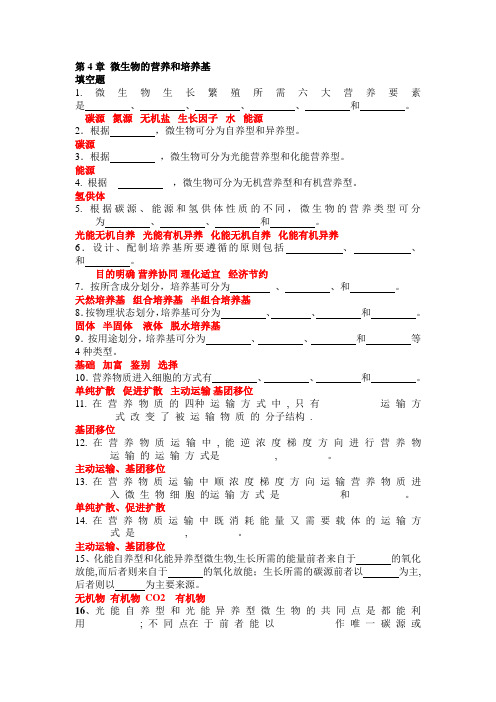
第4章微生物的营养和培养基填空题1.微生物生长繁殖所需六大营养要素是、、、、和。
碳源氮源无机盐生长因子水能源2.根据,微生物可分为自养型和异养型。
碳源3.根据,微生物可分为光能营养型和化能营养型。
能源4. 根据,微生物可分为无机营养型和有机营养型。
氢供体5. 根据碳源、能源和氢供体性质的不同,微生物的营养类型可分为、、和。
光能无机自养光能有机异养化能无机自养化能有机异养6.设计、配制培养基所要遵循的原则包括、、和。
目的明确营养协同理化适宜经济节约7.按所含成分划分,培养基可分为、、和。
天然培养基组合培养基半组合培养基8.按物理状态划分,培养基可分为、、和。
固体半固体液体脱水培养基9.按用途划分,培养基可分为、、和等4种类型。
基础加富鉴别选择10.营养物质进入细胞的方式有、、和。
单纯扩散促进扩散主动运输基团移位11. 在营养物质的四种运输方式中, 只有__________ 运输方式改变了被运输物质的分子结构.基团移位12. 在营养物质运输中, 能逆浓度梯度方向进行营养物运输的运输方式是__________,__________。
主动运输、基团移位13. 在营养物质运输中顺浓度梯度方向运输营养物质进入微生物细胞的运输方式是__________ 和__________。
单纯扩散、促进扩散14. 在营养物质运输中既消耗能量又需要载体的运输方式是__________,__________。
主动运输、基团移位15、化能自养型和化能异养型微生物,生长所需的能量前者来自于_______的氧化放能,而后者则来自于_______的氧化放能;生长所需的碳源前者以_______为主,后者则以______为主要来源。
无机物有机物CO2 有机物16、光能自养型和光能异养型微生物的共同点是都能利用__________; 不同点在于前者能以__________ 作唯一碳源或主要碳源, 而后者则以__________ 作主要碳源, 前者以__________ 作供氢体而后者则以__________ 作供氢体。
食品微生物模拟题

《食品微生物》模拟题卷一一名词解释(20分每题4分)1、转化和转导2、灭菌和商业灭菌3、遗传和变异4、无氧呼吸和有氧呼吸5、脂蛋白和脂多糖二填空题(20分每空1分)1、枯草杆菌合成淀粉酶的场所是。
2、质粒在基因工程中的主要作用是。
3、乳酸发酵可分为、、三种类型。
4、细菌细胞壁的功能主要有、、、、、。
5、微生物在生长过程中与周围微生物相互作用的关系有、、、、。
6、微生物吸收营养物质的方式主要有、、、。
三判断题(如果错误,请说明理由; 20分每题2.5分)1、G+杆菌脱壁后,若进行革兰氏染色后镜检,呈紫色。
2、足细胞是根霉的特征之一。
3、芽孢有极强的抗热,抗辐射,抗化学物和抗静水压的能力,同时具有繁殖功能。
4、消毒可以杀死物体上的所有微生物,包括病原微生物和非病原微生物。
5、处于稳定生长期的菌是研究基本代谢的良好材料和发酵生产的良好种子。
6、嗜冷菌的最适生长温度是低温。
7、食品中蛋白质被微生物分解造成的败坏称为酸败。
8、狭义的生长素是指氨基酸、嘌呤嘧啶碱和维生素。
四简答题(30分每题10分)1、芽胞为什么具有较强的抗逆性 ?(10分)2、与高等植物相比,微生物有哪些特有的特点?(10分)3、简要说明基因工程的主要步骤。
(10分)五问答题(60分每题15分)1、请比较原核细胞与真核细胞的主要区别。
(15分)2、请阐述一下微生物引起食品变质的基本因素。
(15分)3、请阐述微生物的生长量有哪些主要的方法?(15分)4、单细胞微生物生长曲线分为哪几个时期?各有什么特点?(15分)《食品微生物》模拟题卷二一名词解释(20分每题4分)1、原核微生物和真核微生物2、培养基和加富培养基3、烈性噬菌体和温和噬菌体4、发酵和呼吸作用5、菌落和菌苔二填空题(20分每空1分)1、微生物学家巴斯德的主要贡献有____、____、____。
2、微生物现代分类鉴定方法有____、____、____。
3、细菌细胞膜的主要功能有____、____、____、____、____、____。
KJ01微生物营养物质的吸收方式(精)
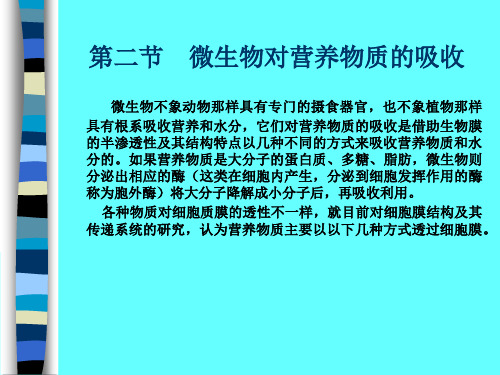
四、基团转位(group translocation)
• 基团转位可转运糖、糖的衍生物,如葡 萄糖、甘露糖、果糖、N-乙酰葡萄糖胺 和β-半乳糖苷以及嘌呤、嘧啶、碱基、 乙酸(但不能输送氨基酸)等。这个运 输系统主要存在于兼性厌氧菌的和厌氧 菌中。但某些好氧菌,如枯草杆菌和巨 大芽孢杆菌(B. megatherium)也利用磷 酸转移酶系统将葡萄糖传送到细胞内。
一、单纯扩散(simple diffusion)
这是通过细胞膜进行内外物质交换最简单的一种方式。营养物
质通过分子的随机运动透过微生物细胞膜上的小孔进出细胞。其 特点是
– 物质由高浓度区向低浓度区扩散(浓度梯度); – 这是一种单纯的物理扩散作用,不需要能量; – 一旦细胞膜两侧的浓度梯度消失(即细胞内外的物质浓度达到平衡, 细胞内外的物质交换达到动态平衡); – 单纯扩散是非特异性的,没有运载蛋白质(渗透酶)参与,也不与 膜上的分子发生反应,扩散的物质本身也不发生改变; – 单纯扩散的物质主要是一些小分子物质,如一些气体( O2、 CO2 )、 水、某些无机离子及一些水溶性小分子(甘油、乙醇等)。
四、基团转位(group translocation)
①少量的 HPr 被磷酸烯醇丙酮酸 (PEP) 磷酸化: 酶Ⅰ PEP + Hpr -------→ 磷酸~HPr+丙酮酸 ②磷酸~HPr 将它的磷酰基传递给葡萄糖,同时将 生成的6-磷酸葡萄糖释放到细胞质内。这步复合反应 由酶Ⅱ催化。 酶Ⅱ 磷酸~Hpr + 葡萄糖----------→ 6-磷酸葡萄糖 + HPr
第二节
微生物对营养物质的吸收
微生物不象动物那样具有专门的摄食器官,也不象植物那样 具有根系吸收营养和水分,它们对营养物质的吸收是借助生物膜 的半渗透性及其结构特点以几种不同的方式来吸收营养物质和水 分的。如果营养物质是大分子的蛋白质、多糖、脂肪,微生物则 分泌出相应的酶(这类在细胞内产生,分泌到细胞发挥作用的酶 称为胞外酶)将大分子降解成小分子后,再吸收利用。 各种物质对细胞质膜的透性不一样,就目前对细胞膜结构及其 传递系统的研究,认为营养物质主要以以下几种方式透过细胞膜。
微生物试题
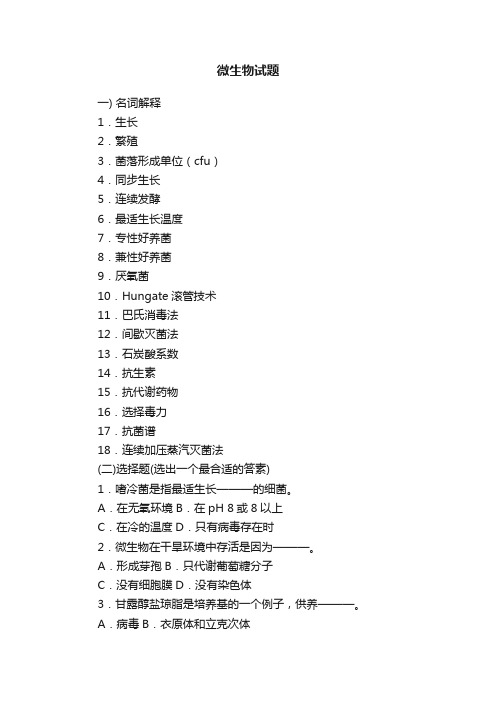
微生物试题一) 名词解释1.生长2.繁殖3.菌落形成单位(cfu)4.同步生长5.连续发酵6.最适生长温度7.专性好养菌8.兼性好养菌9.厌氧菌10.Hungate滚管技术11.巴氏消毒法12.间歇灭菌法13.石炭酸系数14.抗生素15.抗代谢药物16.选择毒力17.抗菌谱18.连续加压蒸汽灭菌法(二)选择题(选出一个最合适的答素)1.嗜冷菌是指最适生长———的细菌。
A.在无氧环境B.在pH 8或8以上C.在冷的温度D.只有病毒存在时2.微生物在干旱环境中存活是因为———。
A.形成芽孢B.只代谢葡萄糖分子C.没有细胞膜D.没有染色体3.甘露醇盐琼脂是培养基的一个例子,供养———。
A.病毒B.衣原体和立克次体C.原生动物和真菌D.某些细菌4.实验室固氮细菌培养基能够加宫通过———。
A.添加ATP B.添加蛋白胨C.添加纯水D.添加钾的水平5.称为微好氧菌的那些细菌能———生长。
A.在高浓度盐中B.在低浓度盐中C.没有ATP或葡萄糖D.在人的口腔内6.有丝分裂过程发生在———。
A.只在细菌中B.在病毒和细胞中C.在真核生物中D.只在化学限定培养基中7.所有微生物的世代时间———。
A.不同B.在30分钟之内C.为3h D.为12h8.出芽繁殖的过程———发生。
A.主要在病毒中B.在形成分支的细菌中C.只在原生动物中D.在酵母菌中9.微生物处于稳定生长前期时————。
A.细胞分裂速率增加B.细胞分裂速率降低C.群体是在其最旺盛壮健的阶段D.群体是在其最少的阶段10.人体病原菌生长的温度在———。
A.100℃B.体温C.像病毒一样的温度D.嗜热的温度11.鉴别培养基是一种培养基,———。
A.其初始pH不同B.可辨别两种不同特性的细菌C.有两种不同细菌所用不同的特殊营养物D.保温培养期采用两种不同的温度12.直接显微镜计数用来测定下面所有微生物群体的数目,除了———之外。
A.原生动物B.真菌孢子C.细菌D.病毒13.生活在pH 5—8.5范围的那些微生物称为———。
- 1、下载文档前请自行甄别文档内容的完整性,平台不提供额外的编辑、内容补充、找答案等附加服务。
- 2、"仅部分预览"的文档,不可在线预览部分如存在完整性等问题,可反馈申请退款(可完整预览的文档不适用该条件!)。
- 3、如文档侵犯您的权益,请联系客服反馈,我们会尽快为您处理(人工客服工作时间:9:00-18:30)。
促进扩散(facilitated diffusion)
特点:在促进扩散过程中 营养物质本身在分子结构上也不会发生变化
不消耗代谢能量,故不能进行逆浓度运输
运输的速率由胞内外该物质的浓度差决定 需要细胞膜上的载体蛋白(透过酶)参与物质 运输
被运输的物质与载体蛋白有高度的特异性
养料浓度过高时, 与载体蛋白出现饱和效应 促进扩散的运输方式多见于真核微生物中,例如通常在厌氧 生活的酵母菌中,某些物质的吸收和代谢产物的分泌是通过 这种方式完成的。
微生物吸收营养物质的方式
1、单纯扩散(simple diffusion or passive diffusion) 被输送的物质,靠细胞内外浓度为动力, 以透析或扩散的形式从高浓度区向低浓度 区的扩散。
Simple diffusion means that the molecules can pass directly through the membrane. Diffusion is always down a concentration gradient. This limits the maximum possible concentration of the molecule inside the cell (or outside the cell if it is a waste product). The effectiveness of diffusion is also limited by the diffusion rate of the molecule. Therefore, though diffusion is an effective enough transport mechanism for some substances (such as H2O), the cell must utilize other mechanisms for many of its transport needs.
可以进行逆浓度运输的运输方式
需要载体蛋白参与 对被运输的物质有高度的立体专一性
被运输的物质在转移的过程中不发生任何化学变化
不同的微生物在主动运输过程中所需的能量的来源不同,好 氧微生物中直接来自呼吸能,厌氧微生物主要来自化学能,光 合微生物中则主要来自光能 。 主动运输是微生物吸收营养物质的主要方式。
1、单纯扩散(simple diffusion or passive diffusion)
特点: ①扩散是非特异性的营养物质吸收方式:如营养物质通过细胞 膜中的含水小孔,由高浓度的胞外环境向低浓度的胞内扩散; ②在扩散过程中营养物质的结构不发生变化:即既不与膜上的 分子发生反应,本身的分子结构也不发生变化; ③物质运输的速率较慢:速率与胞内外营养物质的浓度差有关 ,即随细胞膜内外该物质浓度差的降低而减小,直到胞内外物 质浓度相同; ④不需要载体参与; 扩散是一个不需要代谢能的运输方式:因此,物质不能进行逆 浓度运输。
Comparison of passive and active transport.
Legend:If uncharged solutes are small enough, they can move down their
concentration gradients directly across the lipid bilayer itself by simple diffusion. Examples of such solutes are ethanol, carbon dioxide, and oxygen. Most solutes, however, can cross the membrane only if there is a membrane transport protein (a carrier protein or a channel protein) to transfer them. As indicated, passive transport, in the same direction as a concentration gradient, occurs spontaneously, whereas transport against a concentration gradient (active transport) requires an input of energy. Only carrier proteins can carry out active transport, but both carrier proteins and channel proteins can carry out passive transport.
⑤可运送的养料有限:限于水、溶于水的气体,及分子
量小,脂溶性、极性小的营养物质。
•smosis
flows towards high salt concentraΒιβλιοθήκη ions细胞膜外细胞膜
细胞膜内
单纯扩散模式图
促进扩散 (facilitated diffusion/transport)
营养物通过与细胞膜上载体蛋白(也称作透 过酶permease)的可逆性结合来加快其传递 速度
细胞膜外
细胞膜
恢复原构象 再 循 环
细胞膜内
结 合结 合
构 象 改 变 移位
促进扩散模式图
or active ansport
主动运输(Active transport)
在代谢能的推动下,通过膜上特殊载体 蛋白逆养料浓度梯度吸收营养物质的过 程
主动运输(Active transport)
特点:物质在主动运输的过程中 需要消耗代谢能
Embeded protein:
Proteins that act as carriers are too large to move across the membrane. They are transmembrane proteins. They cycle between two conformations in which a solute binding site is accessible on one side of the membrane or the other.
三
Facilitated diffusion utilizes membrane protein channels to allow charged molecules (which otherwise could not diffuse across the cell membrane) to freely diffuse in a nd out of the cell. These channels comes into greatest use with small ions like K+, Na+, and Cl-. The speed of facilitated transport is limited by the number of protein channels available, whereas the speed of diffusion is dependent only on the concentration gradient.
